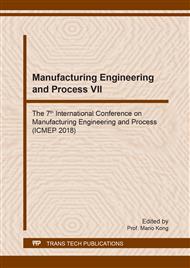p.1
p.15
p.23
p.28
p.39
p.48
p.54
p.63
Overlap Ratio in Wire- and Powder-Based Laser Metal Deposition of H11 + Nb for Hot Forging Dies
Abstract:
AISI H11 tool steel is a complex tool steel alloy used to manufacture hot forging dies. These dies however have a limited life, which depends upon the working conditions, the tool design, the heat treatment, and the quality of tool steels. In this paper, a novel wire-and powder-based laser metal deposition (WP-LMD) process was investigated to deposit H11 wire and niobium (Nb) powder simultaneously and develop a coating on existing forging dies for enhancing their life. The main aim was the development of a novel WP-LMD process, and consequently a new H11 tool steel with improved toughness and hardness. The developed WP-LMD process was later implemented to build a multilayer block made of the modified H11 tool steel. The overlap ratio was optimized in both, horizontal and vertical, directions, and were found to be 30% and 20% respectively in order to achieve a fully dense coating and avoid pores and unmelted Nb particles. The potential of the WP-LMD can be used to fabricate an outer layer of the modified H11 tool steel with improved toughness and hardness, which ultimately enhances the life of hot forging.
Info:
Periodical:
Pages:
28-38
Citation:
Online since:
July 2018
Keywords:
Price:
Сopyright:
© 2018 Trans Tech Publications Ltd. All Rights Reserved
Share:
Citation:


